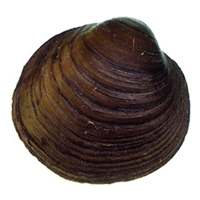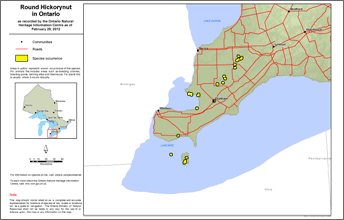Round hickorynut
Scientific name: Obovaria subrotunda

Cover photo credit: Photo Field Guide to the Freshwater Mussels of Ontario
Status
Endangered
“Endangered” means the species lives in the wild in Ontario but is facing imminent extinction or extirpation.
Date added to the Species at Risk in Ontario List
The Round hickorynut was already assessed as endangered when the Endangered Species Act took effect in 2008. It was re-assessed as endangered in 2013.
Read the report (PDF)
What it looks like
The Round hickorynut is a small to medium freshwater mussel that can reach up to 6.5 centimetres long.
It is easily distinguished from other Ontario mussels by its almost perfectly round shape.
The shell is thick, solid, and dark chocolate brown in colour, with a distinctly lighter coloured band along one side.
Where it lives
In Ontario, the Round hickorynut is mainly found in rivers with clay, sand, or gravel bottoms.
It also lives in shallow areas of lakes with firm sand. It prefers moderately fast moving water.
Like all mussels, this species filters water to find food, such as bacteria and algae.
Mussel larvae are parasitic and must attach to a fish host, where they consume nutrients from the fish body until they transform into juvenile mussels and drop off.
The fish hosts of the Round hickorynut in Canada have not been confirmed but may include the Greenside darter and the Eastern sand darter, which is also a species at risk.
The presence of fish hosts is one of the key features for an area to support a healthy mussel population.
Where it’s been found in Ontario
The Round hickorynut has been lost from 90 per cent of its former range in Canada.
It is now found only in the Sydenham River and the St. Clair River delta in Lake St. Clair in southwest Ontario.
Populations have been lost from the rest of Lake St. Clair, the Thames River, the Detroit River, Lake Erie and the Grand and Niagara River drainages.
View a Larger version of this map (PDF)
What threatens it
The greatest threats to the Round hickorynut are pollution and siltation, which occurs when too much soil washes into the river from nearby agricultural and urban areas.
The Zebra mussel, an invasive species from Europe, is a serious threat because it attaches to native mussels and can kill them by interfering with breathing, feeding, excretion and movement.
Conditions that threaten the fish host species also threaten the Round hickorynut.
Action we are taking
Endangered Species and their general habitat are automatically protected.
Recovery strategy
A recovery strategy advises the ministry on ways to ensure healthy numbers of the species return to Ontario.
Read the executive summary (September 10, 2010)
Read the recovery strategy (September 10, 2010)
Government response statement
A government response statement outlines the actions the government intends to take or support to help recover the species.
Read the government response statement (June 15, 2011)
Five-Year Review of Progress
A five-year review reports on progress made toward protecting and recovering a species, within five years of publishing a species’ government response statement.
Read the report on progress towards the protection and recovery of 27 species at risk, including Round Hickorynut (2016).
Habitat protection
General Habitat Protection - June 30, 2013
What you can do
Report a sighting
Report a sighting of an endangered animal or plant to the Natural Heritage Information Centre. Photographs with specific locations or mapping coordinates are always helpful.
Volunteer
Volunteer with your local nature club or provincial park to participate in surveys or stewardship work focused on species at risk.
Be a good steward
- private land owners have a very important role to play in species recovery; if you find Round hickorynut in a watercourse on or adjacent to your property, you may be eligible for stewardship programs that support the protection and recovery of species at risk and their habitats
- invasive species seriously threaten many of Ontario’s species at risk; to learn what you can do to help reduce the threat of invasive species, visit:
- farmers and land owners can help improve mussel habitat and keep Ontario’s water safe and clean by maintaining natural vegetation next to creeks and rivers, and keeping pollution and soil from washing into Ontario’s streams and rivers; for more information about programs and funding assistance for eligible land owners visit the Ontario Soil and Crop Improvement Association website
Report illegal activity
Report any illegal activity related to plants and wildlife to
Quick facts
- it is estimated that Round hickorynut populations in Canada have declined by more than 90 per cent since the invasion of the Great Lakes by Zebra mussels
- mussels are indicators of environmental health; since they have a complex life cycle, are long-lived and feed by filtering water and its pollutants, mussels can provide a snapshot of how healthy our waterways are
- aboriginal people harvested mussels for food and to create jewelry and tools; in the 1800s, massive numbers of mussels were harvested from the Grand River to create buttons; millions were shipped out every year until the 1940s when plastic buttons became more popular
